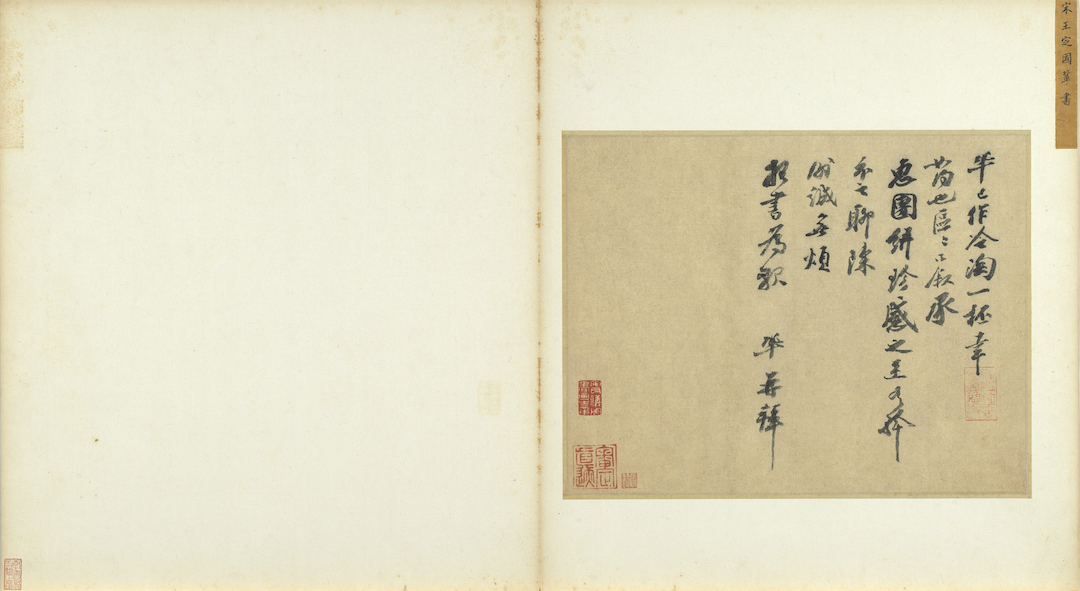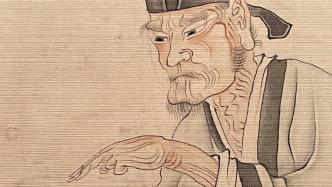
Ming Dynasty calligrapher and painter Chen Hongshou (1598-1652), known as Laolian, has a profound influence on the history of Chinese figure painting. His personality is arrogant and arrogant. He is unique in the Ming and Qing Dynasties. , Mr. Lu Xun especially loves his character prints, saying "Lao Lian's paintings are a masterpiece of a generation".
2022 is the 370th anniversary of Chen Hongshou's death. On September 28, "Gao Gu Qihao - Chen Hongshou's Painting and Calligraphy Exhibition" was officially exhibited at Xuwei Art Museum (Shaoxing Museum Branch). Masterpieces such as "Avalokitesvara", "Lady with Flowers", "Portrait of Zhong Kui", "The Goose in the Right Army's Cage" and "Silk Bamboo in the Shadow of Banana" were all exhibited.
The exhibition is sponsored by the Shaoxing Municipal People's Government. The co-organizers include the Propaganda Department of the Shaoxing Municipal Committee of the Communist Party of China, the Shaoxing Municipal Bureau of Culture, Broadcasting and Tourism, the Shaoxing Municipal Federation of Literary and Art Circles, and the Shaoxing Municipal Culture and Tourism Group. The organizer is the Shaoxing Museum (Xuwei Art Museum). The exhibition is held in Shaoxing. On the basis of the museum's collection resources, it has been lent to 35 cultural and museum units and ancient book collection units such as the Palace Museum, the National Museum of China, the National Art Museum of China, the Shanghai Museum, the Nanjing Museum, and the Liaoning Provincial Museum. There are a total of 100 pieces (groups) of his teachers and friends, post-study calligraphy and painting, and ancient books.

Part of the Volume of "Five Laos of Huashan"

"Gao Gu Qi Hao - Exhibition of Chen Hongshou's Painting and Calligraphy"
Walking into the Xu Wei Art Museum, which is located near the Qingteng Book House, the black tiles and white walls give people a fresh and distant feeling. Entering the exhibition hall on the second floor, the surging journalists saw at the scene that the exhibition was presented in four chapters including "Yuezhong Family", "Gao Gu Qi Hao" and "Ancient Elegant and Beautiful". It is understood that this exhibition is also another cultural event held in Shaoxing following the 2021 "Deranged Ivy - Xu Wei's Painting and Calligraphy Exhibition".
It is reported that Chen Hongshou once lived in Xu Wei's former residence Qingteng Book House before his death. This is also after a lapse of 500 years.
Ding Ruxing, member of the Standing Committee of the Shaoxing Municipal Party Committee and Minister of the Propaganda Department, said at the opening ceremony that Shaoxing is a famous historical and cultural city and the cultural capital of East Asia. Chen Hongshou is one of the outstanding representatives of Shaoxing's 2,500-year history. Especially in his figure paintings, on the basis of learning from the ancients, he is free from conventions and bold innovations. There has been no such ink in a hundred years.” "This exhibition has been strongly supported by 35 units including the Palace Museum and the National Museum of China. Among the 100 pieces (groups) of cultural relics on display, there are 20 pieces (groups) of first-class cultural relics. Next, Shaoxing will hold Celebrity cultural events such as Wang Yangming's 550th birthday and the 2nd Luyou Poetry Festival have continuously made Yue culture, canal culture, calligraphy culture, poetry culture, Song Yun culture, and Yangming culture into cultural symbols with local recognition." Ding Ruxing said.
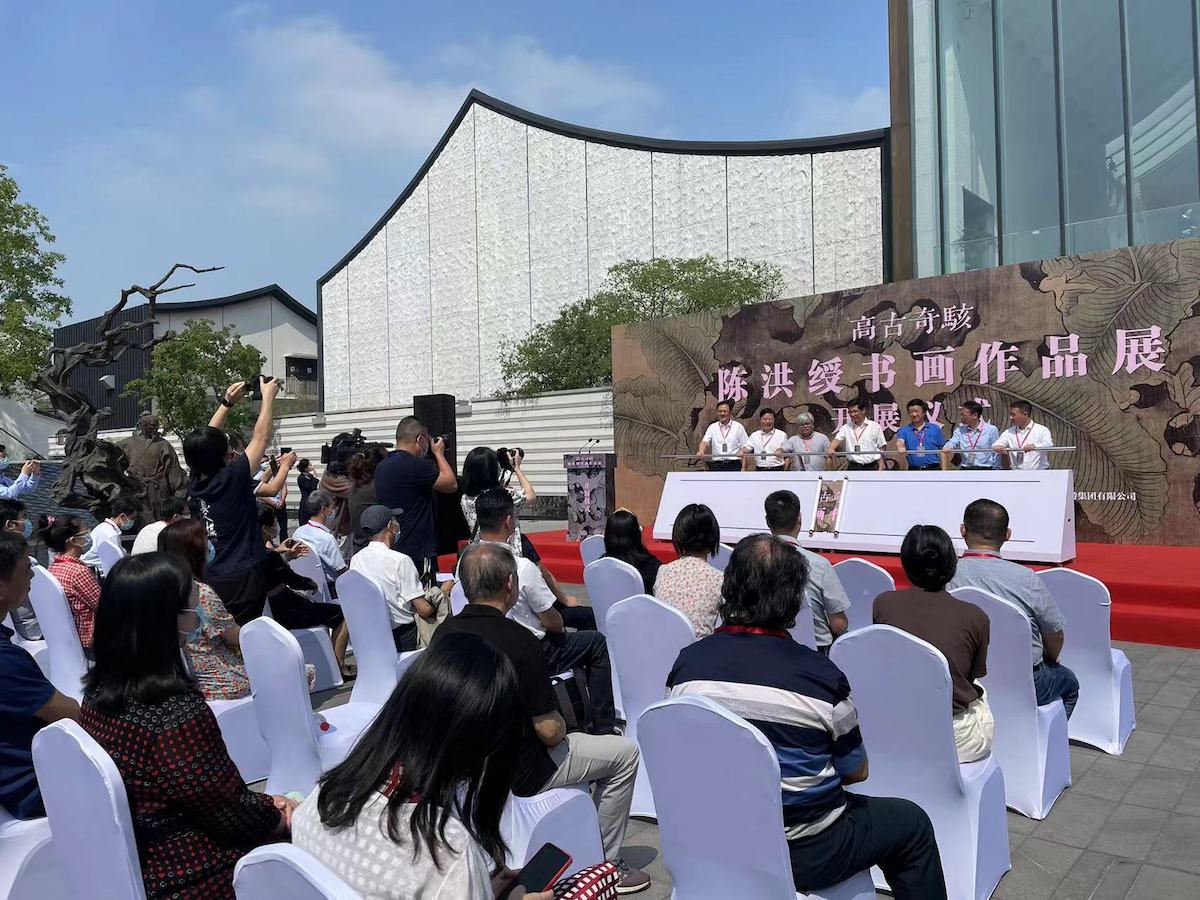
The opening scene of "Gao Gu Qi Hao - Chen Hongshou's Painting and Calligraphy Exhibition"
Among the cultural relics on display this time, there are 56 works of calligraphy and painting by Chen Hongshou. In addition to the "high ancient and strange" figure paintings, there are also quaint and beautiful flower and bird paintings, new landscape paintings from the ancients, and prints with ease and harmony (replica). ), fresh and handsome calligraphy and simple and honest poetry. Among them, there are many masterpieces such as "Guanyin", "Lady with Nianhua", "Zhong Kui", "You Army Cage Goose", "Silk Bamboo in the Shadow of Banana" and other masterpieces. An in-depth interpretation of the unique artistic spirit.

Chen Hongshou's "Bao Lun Tang Collection"
"This exhibition is divided into four exhibition halls, the first exhibition hall tells about Chen Hongshou's family background, life and teacher's inheritance; the second exhibition hall focuses on his 'high ancient and strange' figure paintings, because Chen Hongshou's figure paintings are the most exquisite, and at the same time in the In this exhibition hall, we also show some of his flower and bird paintings; in the third exhibition hall, we show his landscape, calligraphy and poetry; finally, we show his influence on later generations.” The curator of this exhibition, In an interview with The Paper at the exhibition site, Shen Yiping, deputy director of the Shaoxing Museum, said, "At the beginning of the exhibition, we used a very classic sentence from Chen Hongshou's "Bao Lun Tang Collection": 'For example, with the rhyme of the Tang Dynasty, the rhythm of the Song Dynasty, and the rationale of the Song Dynasty, At the end of the exhibition, we also used his sentence, 'Learn from his meaning, create the world for himself'. From the two sentences before and after, we can read his teacher's inheritance and artistic origin, It can be seen that his inheritance is orderly and innovative. This artistic spirit is also a response and inspiration to the present. This is the reason for Chen Hongshou's success, the core of the exhibition, and the reform and opening up of contemporary Shaoxing. core and soul.”
"Gao Gu Qi Hao, not close to the ears and eyes to play"
Chen Hongshou (1599-1652), courtesy name Zhanghou, nicknamed Laolian, Huichi, etc., was born in Chenjia Village (now Zhuji City), Fengqiao Town, Zhuji County, Shaoxing Prefecture, Zhejiang Province in the Ming Dynasty. He was a famous calligrapher, painter and poet. Also known as the "Three Sages of Zhuji". When he was young, he learned painting from Lan Ying and Sun Hao, and later he worked with Liu Zongzhou as a supplementary student. Painting for a living. He was known for his paintings all his life, especially in portraiture, and together with Cui Zizhong, he was called "South Chenbeicui", especially in portraiture. Above the British) and Tang (Yin), there is no such brush and ink in the Ming Dynasty for three hundred years.” Mr. Lu Xun especially loves Chen Hongshou's figure prints, saying that "Lao Lian's paintings are a masterpiece of a generation".
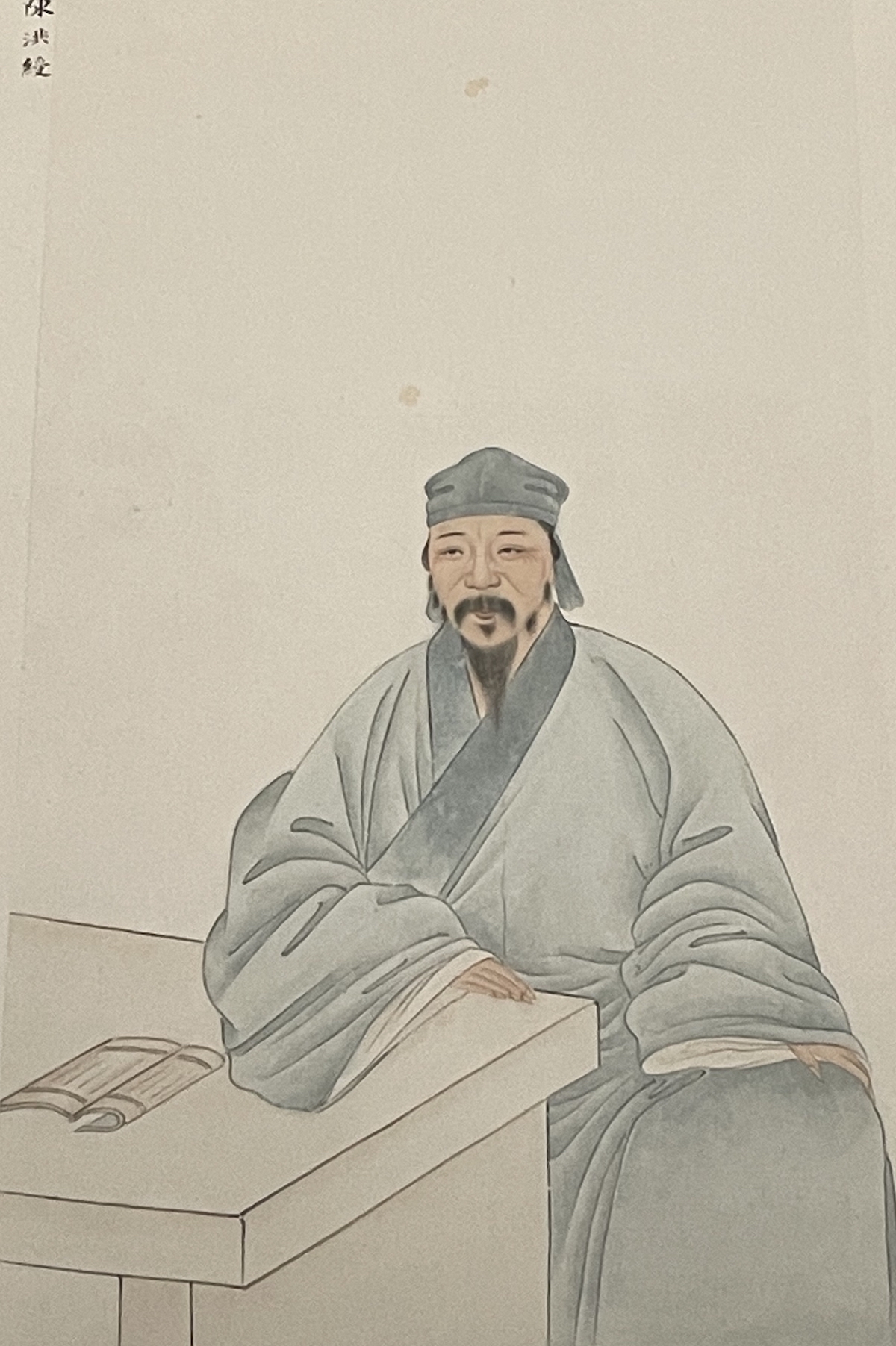
Yang Pengqiu's painting "The Second Collection of Portraits of Qing Dynasty Scholars: Chen Hongshou" Collection of the National Museum of China
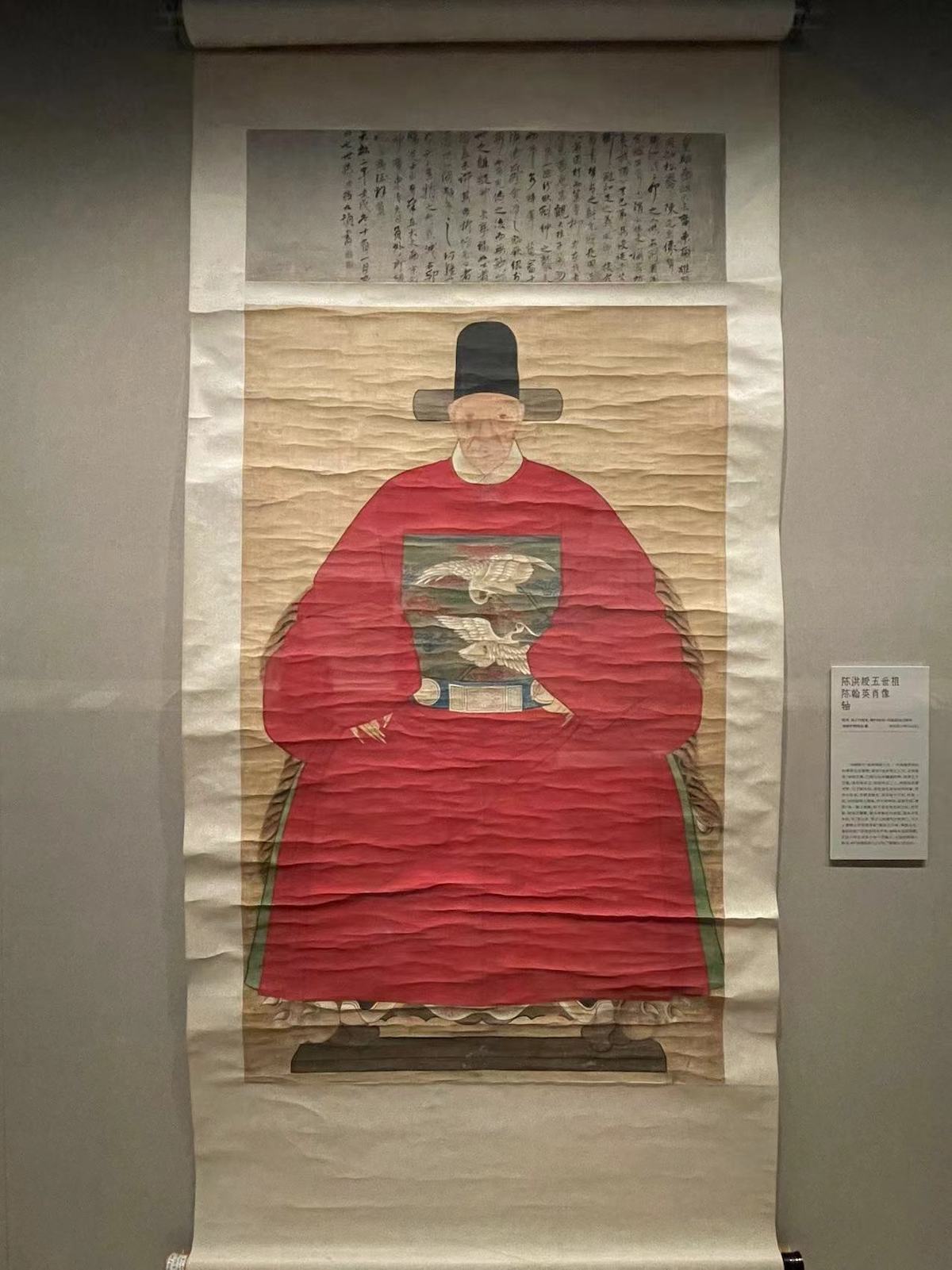
Portrait of Chen Hanying, the fifth ancestor of Chen Hongshou, in the collection of Zhuji Museum

Portrait of Mrs. Chen Hanying, grandmother of Chen Hongshou V, in the collection of Zhuji Museum
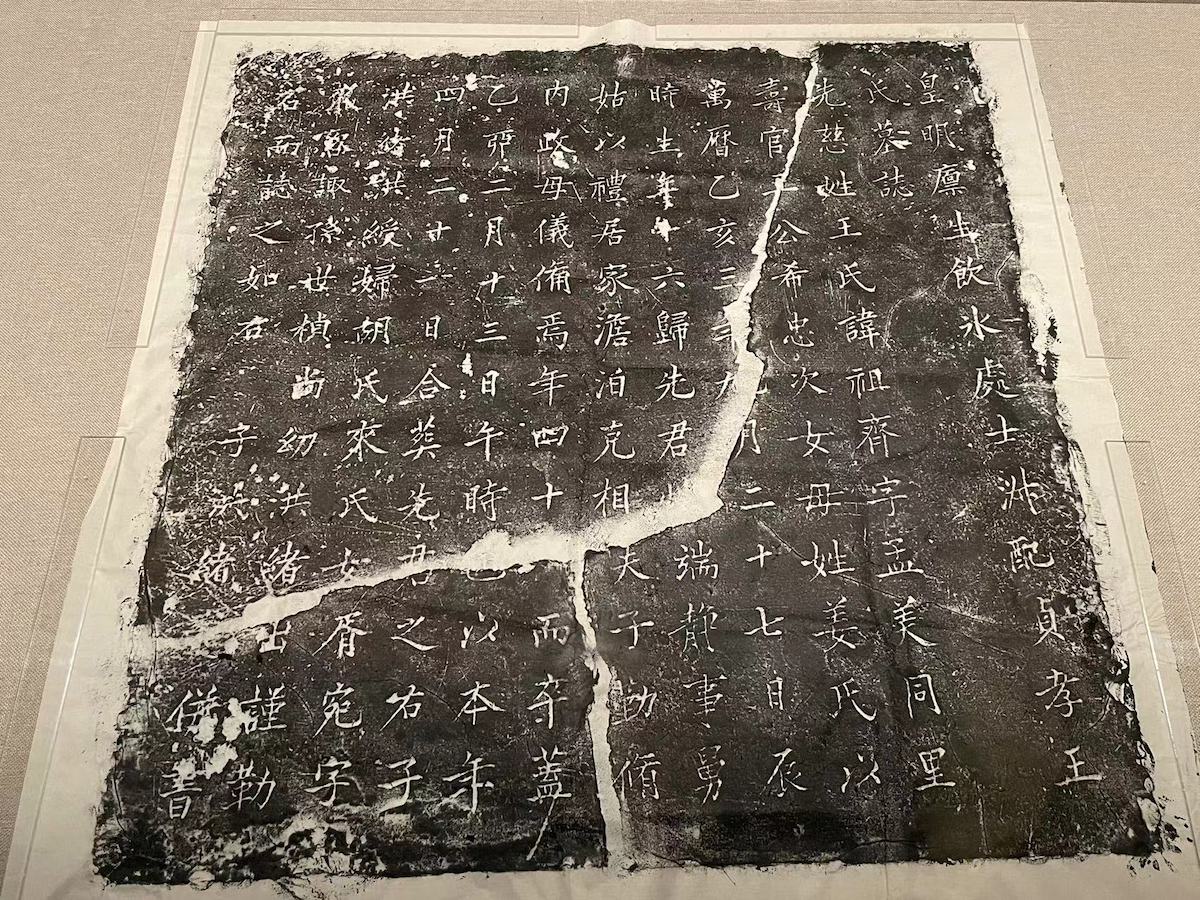
Chen Hongshou's mother Wang's epitaph in the collection of Zhuji Museum
The Chen family belonged to a family of hairpins. After the change of Jingkang, the ancestor Chen Shou went south from the Song Dynasty and moved to Fengqiao, Zhuji, from Henan. His grandfather, Chen Xing, was an academic official and became a political envoy. Although his father, Chen Yuchao, was not an official, he made friends with contemporary celebrities such as Tu Long, Xu Wei, and Chen Jiru. Chen Hongshou showed his talent for painting when he was a child at the private school of his in-laws in Xiaoshan. When he was ten years old, he went to Hangzhou to learn painting under the tutelage of famous masters Lan Ying and Sun Hao. The two had a great influence on others. Their works have obvious origins in terms of composition and coloring. Later generations even changed Sun Hao's paintings to The author of Chen Hongshou charged a high price. However, Chen Hongshou's artistic talent soon made the two seniors in the art world feel inferior.
The first section of the exhibition, "Yuezhong Family", presents the influence of his teachers and family, including the portraits of his fifth grandparents, his father Chen Yuchao's pen and ink among friends and friends, his teachers Lan Ying, Liu Zongzhou, and Fu Wenglai. The surviving inkblots of Si Xing et al.
Chen Hongshou's artistic achievements, first of all in figure painting and printmaking, especially figure painting is an important contribution to the history of Chinese art. His early works were modeled after the Tang and Song Dynasties, with lines like gossamers, round and long, and empty backgrounds; in the mid-term, his creations became more exaggerated, and he used round and square pens. The stone utensils are in the painting, the shape is exaggerated, the expression is calm, and the image is ancient. Zhou Lianggong's "Reading Paintings" in the Qing Dynasty recorded that the world was "surprised by its grotesqueness".

Chen Hongshou's "Avalokitesvara Scroll" Collection of Jilin Provincial Museum

Chen Hongshou "Plum Appreciation Scroll" Collection of Juntao Art Institute
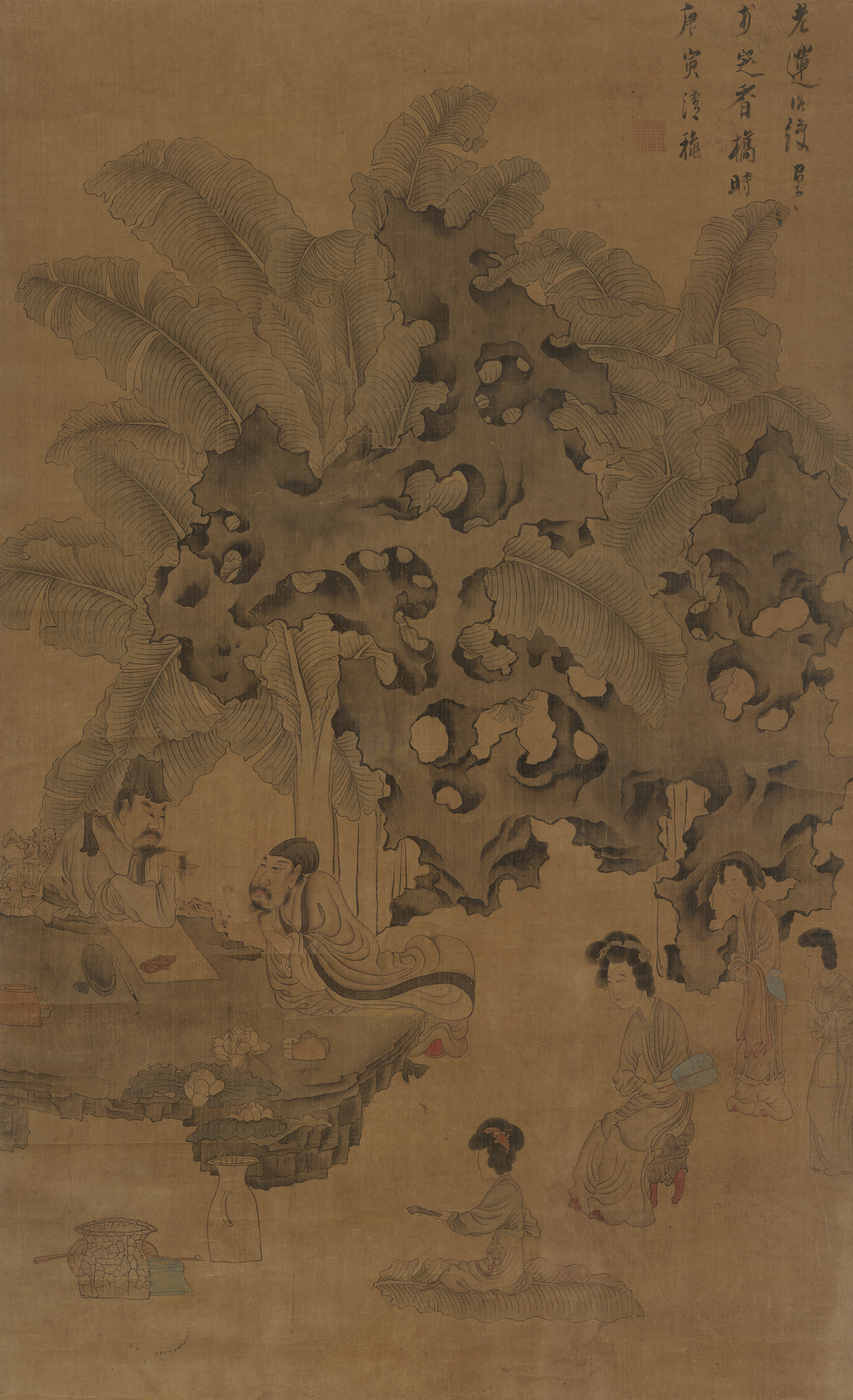
Chen Hongshou, "Silk and Bamboo Scroll in Banana Shade" Collection of Shaoxing Museum
The "Silk Bamboo in the Shadow of Bananas" exhibited this time is a representative work of his figure paintings in his later years. In the painting, the banana forests cover the sun, the lakes and rocks stand out, and Gao Shi has a drink, or tastes silk and bamboo, showing the leisure time of escaping the world. Basho has an illusion and eternity in Buddhism, and its motif may be a portrayal of his heart.

Picture of Chen Hongshou's right army cage goose
Chen Hongshou often painted Taoism, historical or legendary figures as the subject of his paintings, and there are many cases of multiple births, such as "The Portrait of Zhong Kui" and "The Cage of Goose", etc., many of which have survived. Among them, the "Portrait of Zhong Kui" in the Suzhou Museum and the "Portrait of Zhong Kui" in the Shanghai Academy of Chinese Painting are highly similar in character. On the painting, Zhong Kui looks like a rickety old man, with black hat and flower hairpin, black clothes with dragon pattern, jade belt and keys.
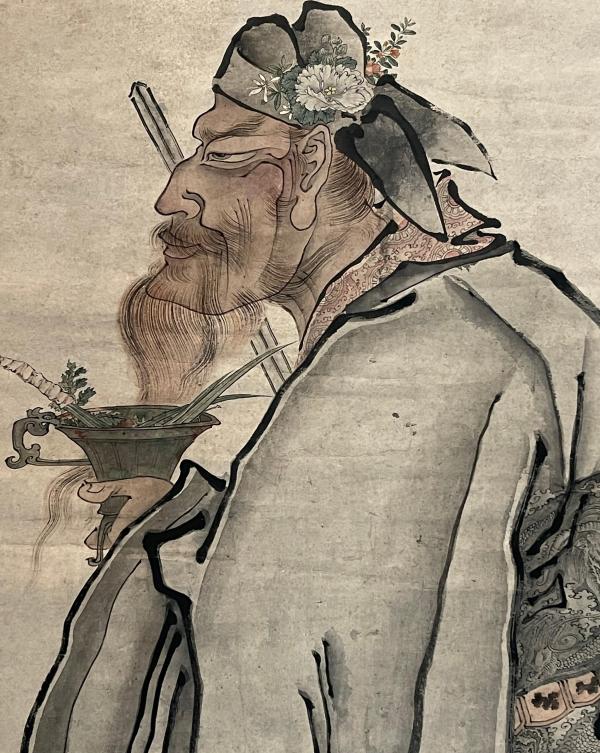
Part of Chen Hongshou's "Portrait of Zhong Kui" in the collection of Suzhou Museum
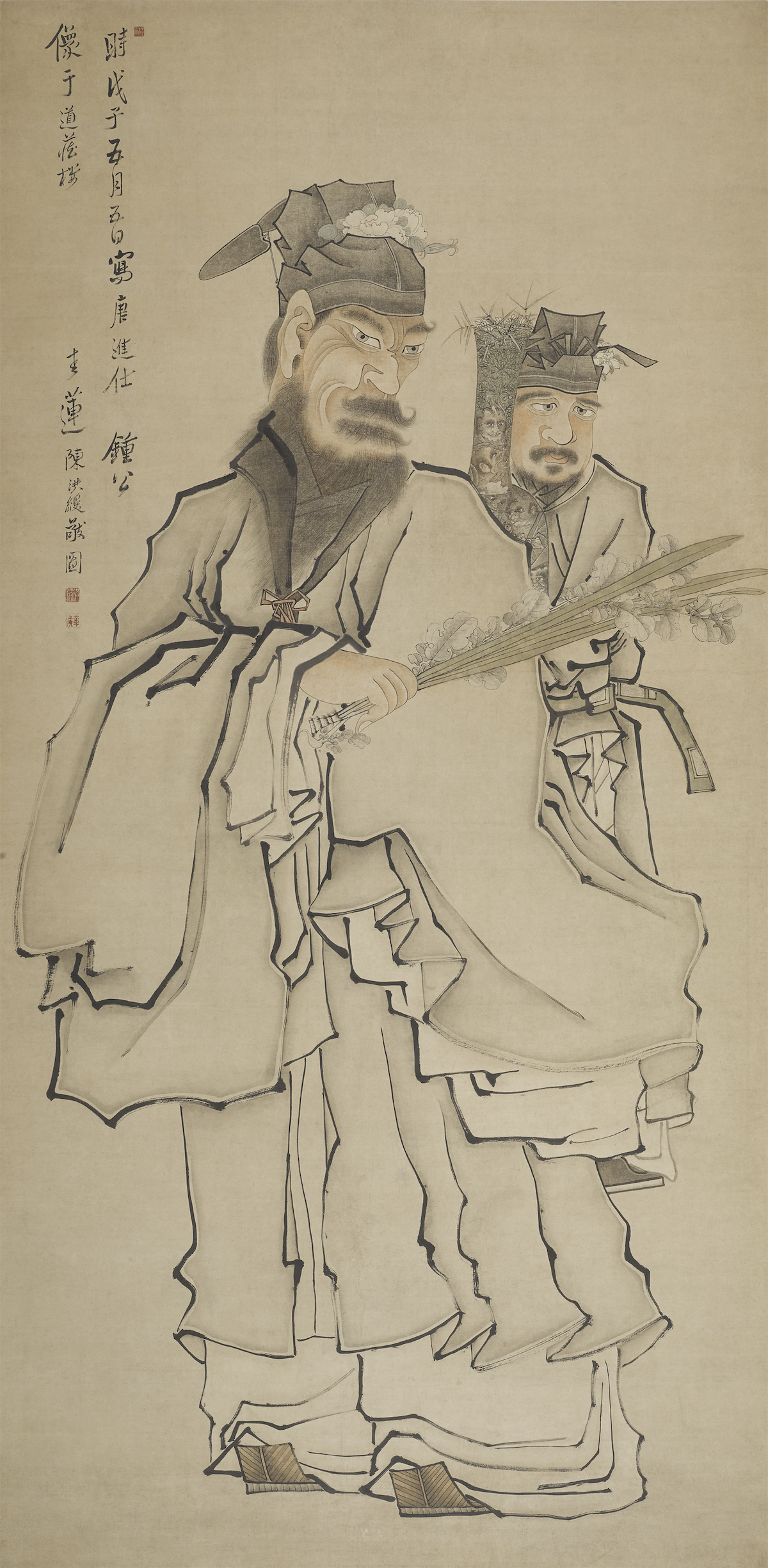
Chen Hongshou "Zhong Kui Statue Scroll" Collection of National Art Museum of China
Wearing flowers on the hat is an innovation of Chen Hongshou in the image of Zhong Kui, and this feature is also maintained in the "Portrait of Zhong Kui" in the National Art Museum of China. This edition of "Portrait of Zhong Kui" has a full composition, and an attendant is added behind Zhong Kui. The two editions of "The Portrait of Zhong Kui" are quite similar in the use of brushes. The details of the characters are all outlined by the gossamer drawing method, the clothes pleats and hooks are like iron line drawing, and the strokes are dignified and square-folded, with the implication of gold and stone.

Chen Hongshou's "Avalokitesvara Scroll", the image of Guanyin sending off his son in the collection of the Palace Museum
Chen Hongshou's "Avalokitesvara Scroll" depicts the image of Guanyin sending his son. Guanyin is female, with a broad nose and long eyes, her face is slightly old, and the white hair on her forehead shows her status as a god. The baby in his arms is dressed in red and holds a lotus flower. The author uses "nail head and mouse tail drawing" to outline the figure's clothing pattern, which is strong and square. When depicting the figure's face and hands, the lines are soft and smooth.
The combination of Guanyin and sending children is a classic case of the localization of Buddhism. According to the "Miaofa Lotus Sutra·Avalokitesvara Universal Door Pin", Guanyin Bodhisattva has the power of "responding to men and women". Since the Song Dynasty, the folks have combined the white-robed Guanyin with sending children.

"Five Laos of Huashan" volume (detail)
In the "Five Laos of Huashan" volume, the old man's shape is clear and thin, his mouth is sunken, and he seems to be using a pen without a pen. His chin and cheekbones are high and convex, and his facial structure is very accurate. The scroll depicts the scene of Chen Hongshou's contemporaneous social sages gathering for a literary meeting. The figures in the picture include Yuan Zongdao, Yuan Hongdao, Mi Wanzhong (descendant of Mi Fu), Tao Wangling, etc., using realistic techniques, on the basis of appearance, to express Their celebrity demeanor also shows his profound realism skills. Relevant scholars believe that this kind of grotesque beauty comes from intentional deformation. He uses deformation techniques to express the strangeness of the picture, and uses deformation techniques to express his "childishness", but the more childish, the more ancient and elegant. "The character of the old lotus, won the ancient method" "high ancient and strange, all are not close to the ears."
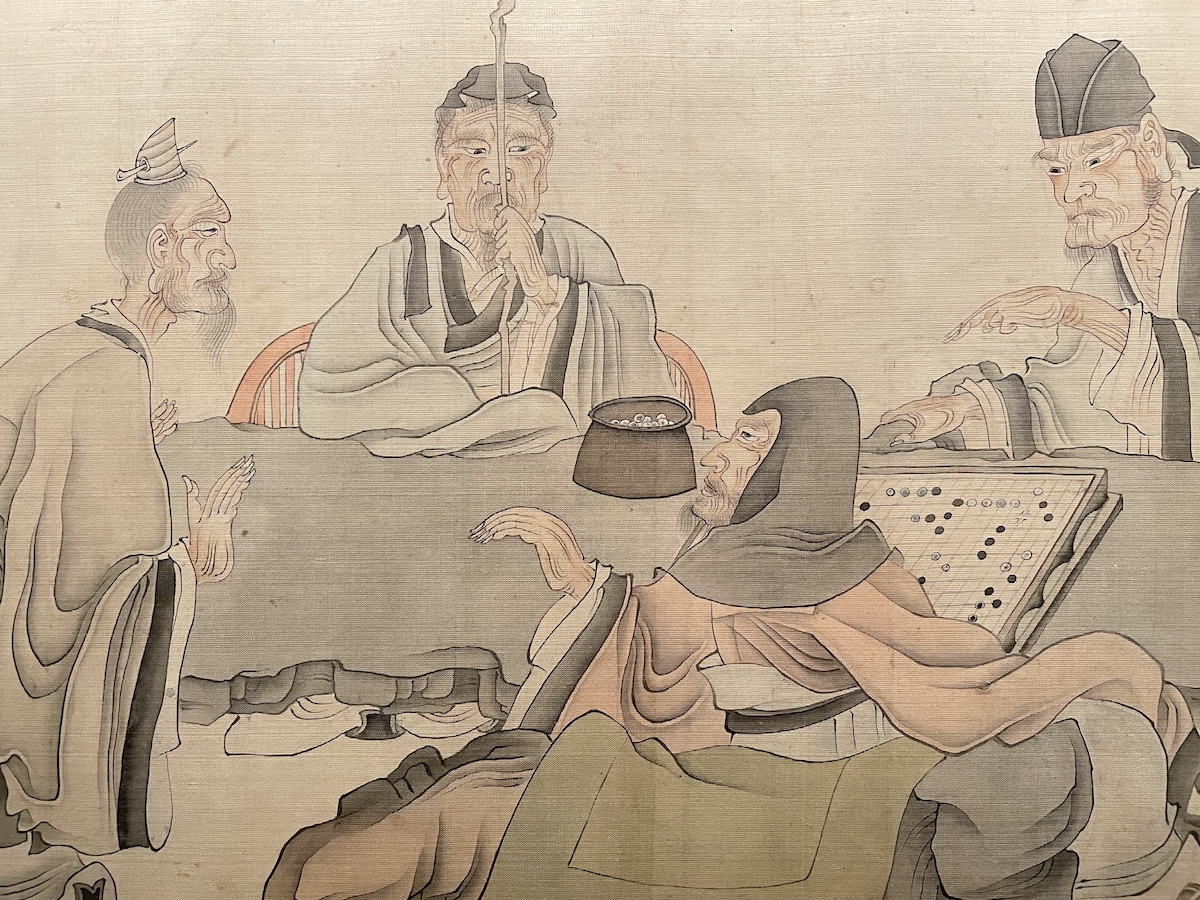
"Five Laos of Huashan" volume

Part of the Volume of "Five Laos of Huashan"

Part of the Volume of "Five Laos of Huashan"
"Fengshen Clothes, Yiyi has a fairy spirit"
The prominent features in Chen Hongshou's portraits of ladies are drooping eyebrows, raised eyes, big noses, and small mouths, but they have an unusual mood and mood. The ladies do not focus on writing shapes, but on writing about their graceful charm and extraordinary mental state. "(Chen)'s pictures of ladies, Fengshen's robes, Yiyi has a fairy spirit."
For example, the Shanghai Museum's "Picture Scroll of Ladies Fluttering Butterflies" on display this time depicts two ladies making a butterfly play. The figure has a huge head and a slender body, which is a typical gesture of the old lotus lady.
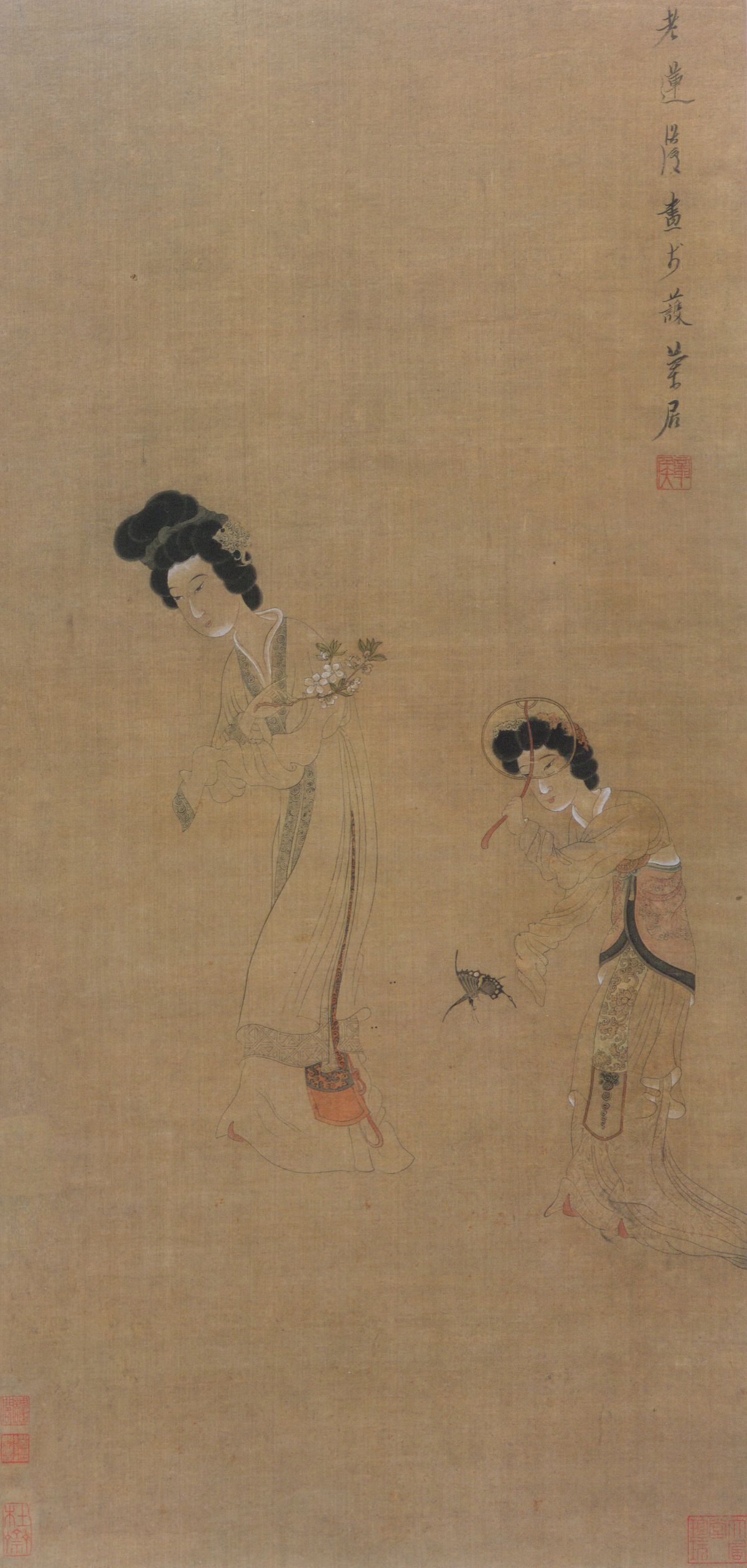
Chen Hongshou's Butterfly Ladies
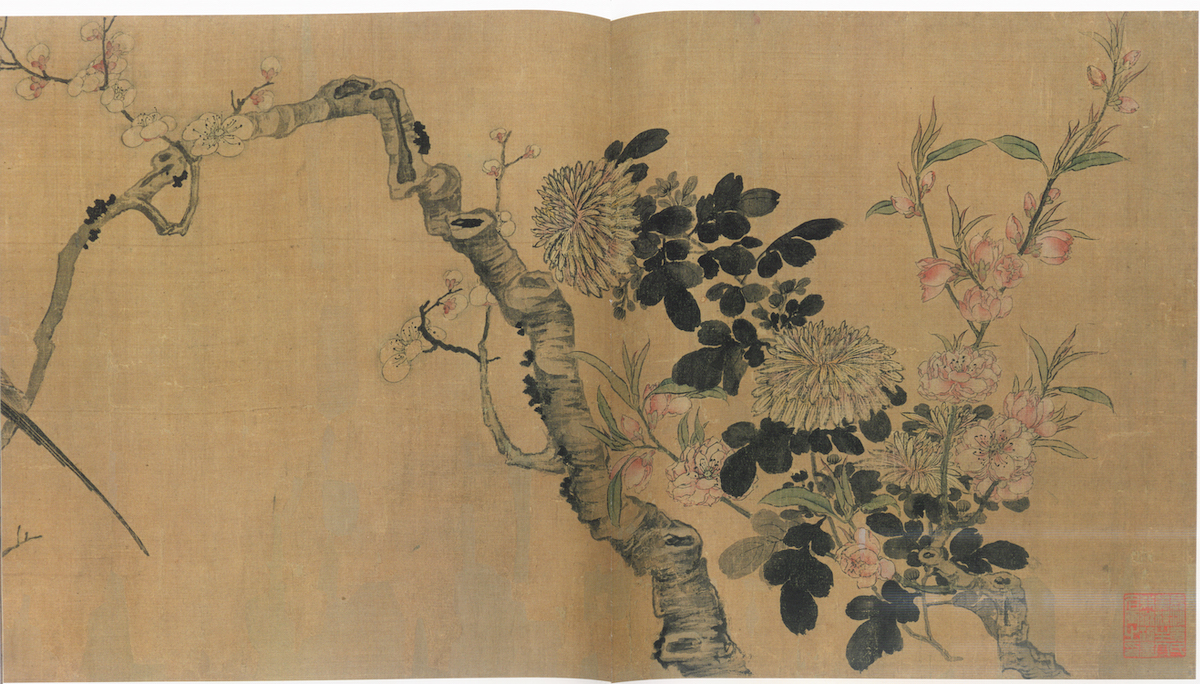
Chen Hongshou Flowers, Birds, Grass and Insects (Partial) Collection of Shanghai Museum
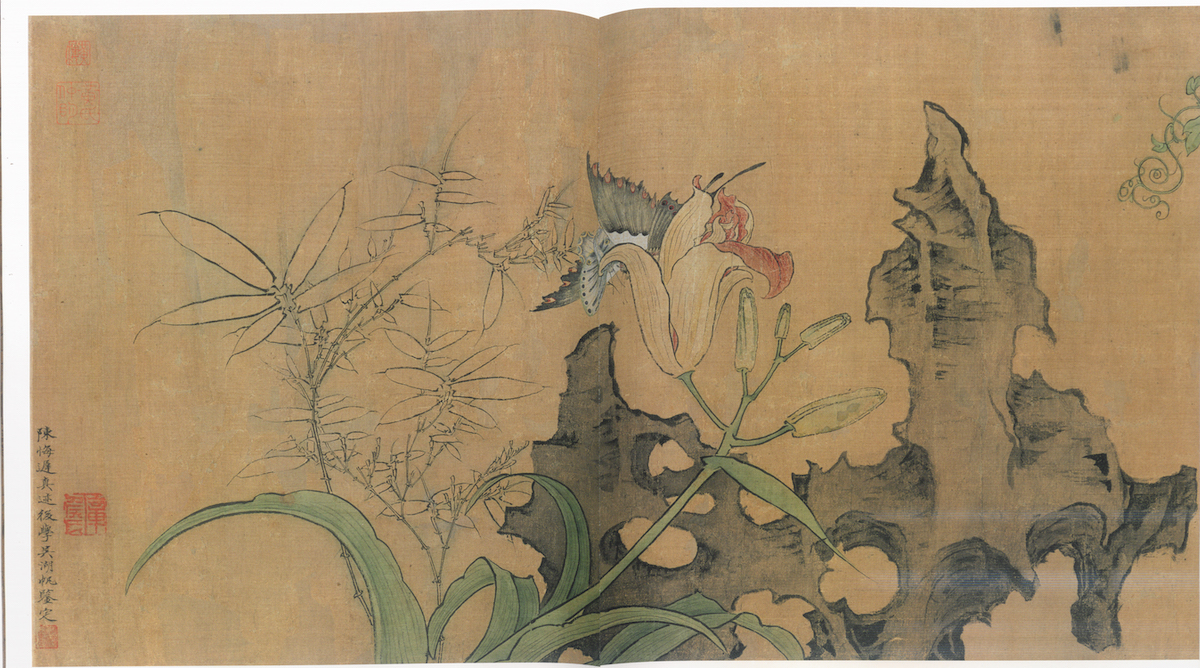
Chen Hongshou Flowers, Birds, Grass and Insects (Partial) Collection of Shanghai Museum
Flowers, birds, plants and insects are also Chen Hongshou's favorite themes, and he also shows his realistic skills. The "Flowers, Birds, Grass and Insects" exhibited this time paints flowers such as peach, chrysanthemum, plum, morning glory, bamboo, and scorpion, including birds and nymphs. , Praying mantis interspersed among them, except for chrysanthemum leaves, which are boneless, others are colored with double hooks, which is extremely beautiful.
"Miscellaneous Paintings" has flowers and birds, butterflies, trees, rocks, figures and so on. Five of the pages have Yun Shouping's counter-topics, which add a lot to the album. Its flowers, birds and Cordyceps are finely outlined, beautifully colored, and light and light; the lines of the figures are clear, round and fine, and the lines are clear, round and fine, and the lines are clear, elegant, and the style is vigorous.

One of Chen Hongshou's "Miscellaneous Paintings" Collection of Nanjing Museum
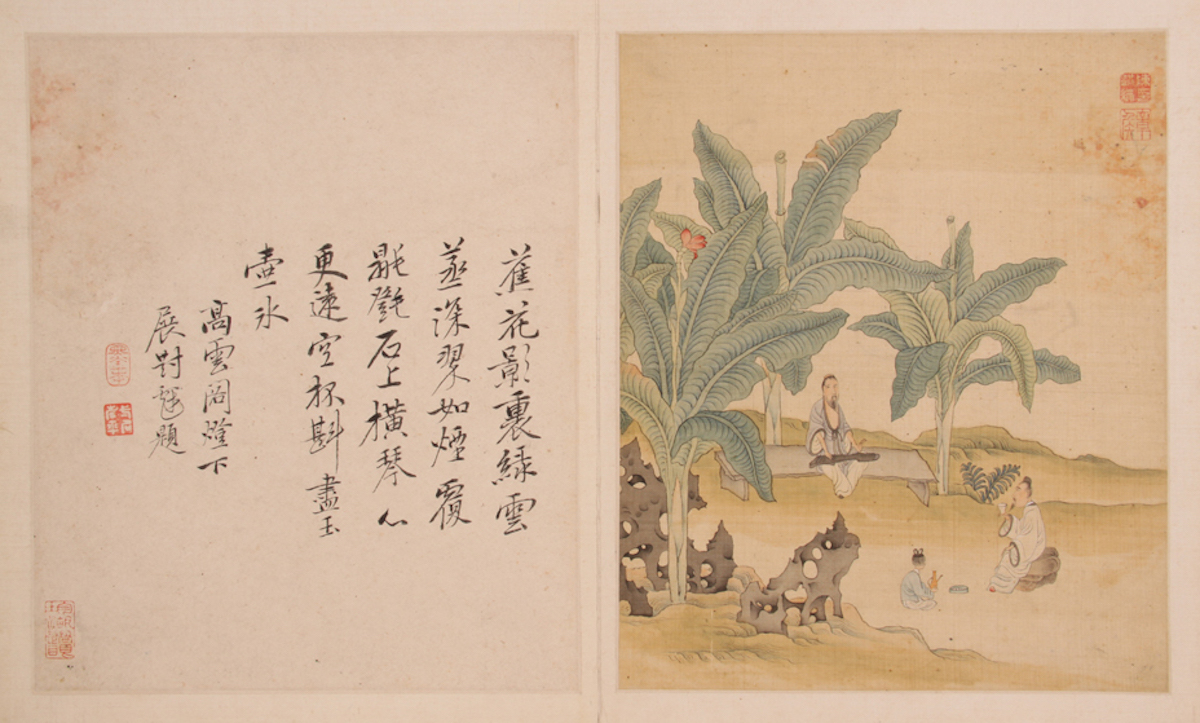
One of Chen Hongshou's "Miscellaneous Paintings" Collection of Nanjing Museum
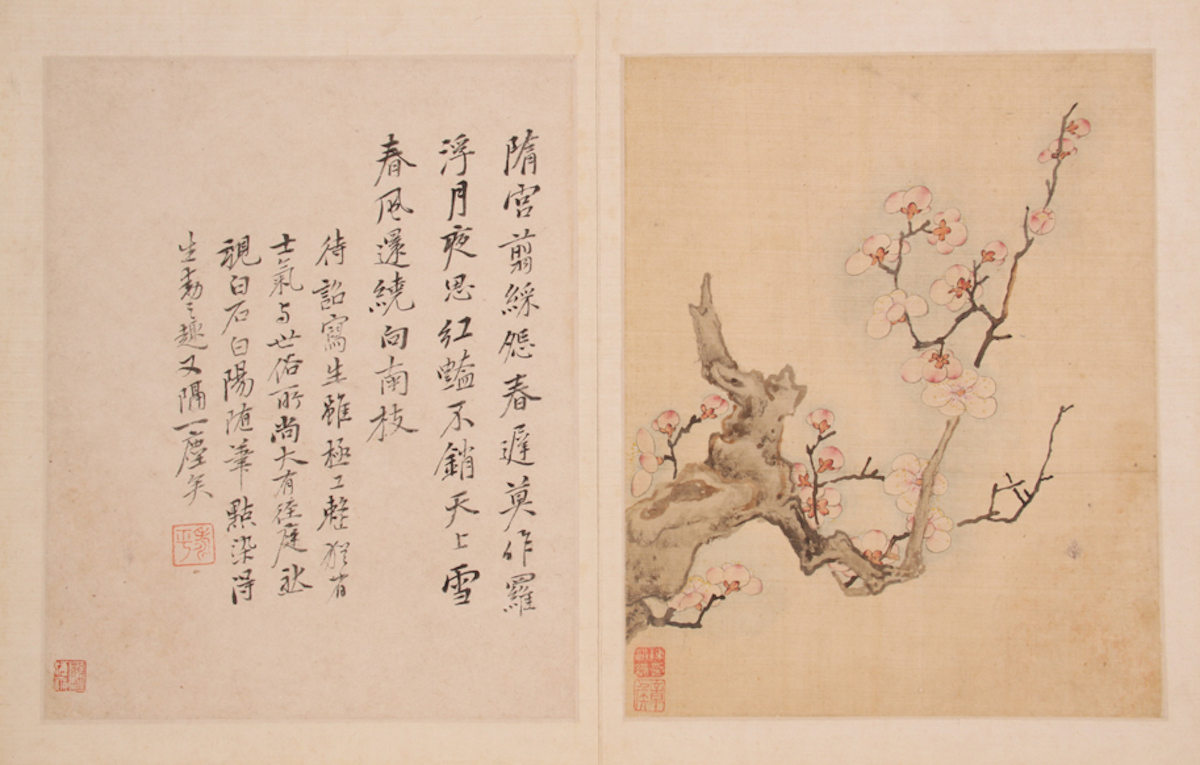
One of Chen Hongshou's "Miscellaneous Paintings" Collection of Nanjing Museum
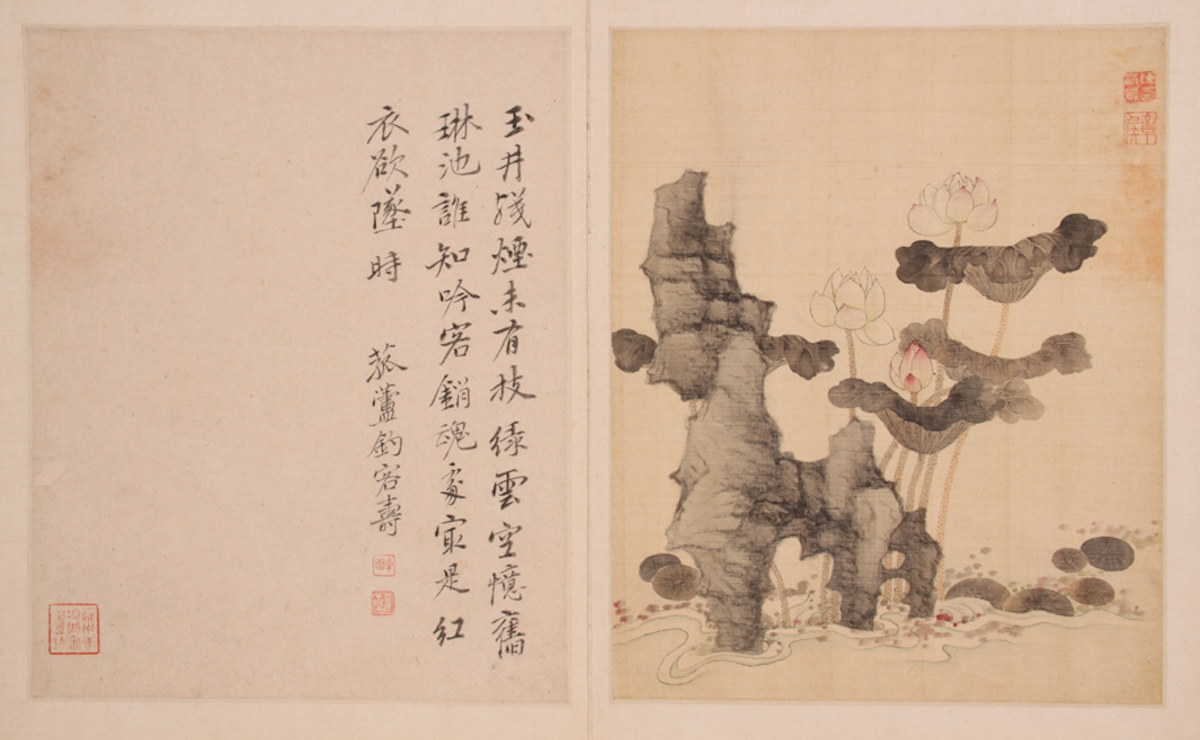
One of Chen Hongshou's "Miscellaneous Paintings" Collection of Nanjing Museum
Chen Hongshou has been engaged in the art of printmaking throughout his life, and has been widely circulated in the world in the form of book illustrations. There are a large number of his works, including "Nine Songs", "The Story of the West Chamber", "Mandarin Duck Tomb", "Water Margin Leaves" and "Bogu Leaves", all of which were engraved by famous engravers of his contemporaries. They were woodcuts in Ming and Qing Dynasties representative work. The exhibition also presents the version of his prints.
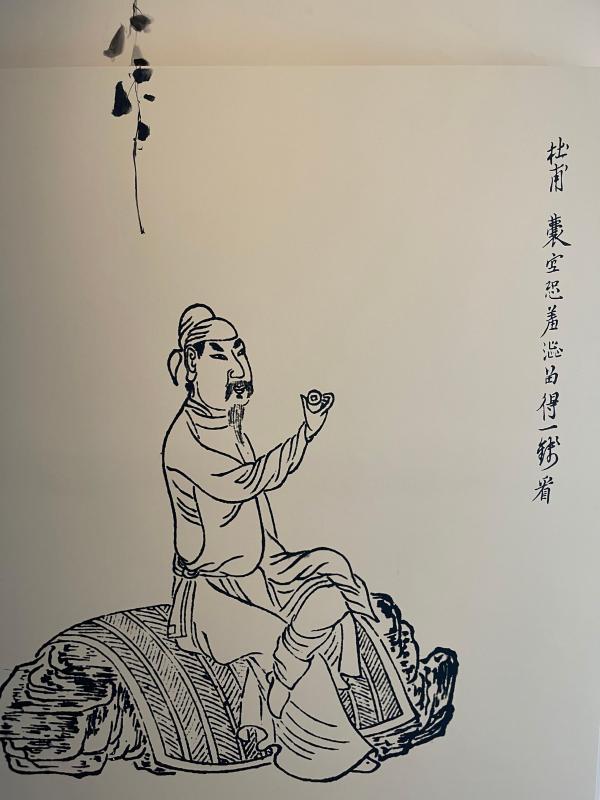
The statue of Du Fu in "Bogu Leaves" became the scenery of this exhibition
In 1638, when Lai Qinzhi's "Chu Ci Shu Zhu" was published, Chen Hongshou's "Nine Songs" was used as an illustration and put into woodcut, which had a great influence. The image of Qu Yuan he created has been surpassed by no one in the Qing Dynasty for more than two centuries, and is regarded as the classic work of Qu Yuan.
"Water Margin Leaves" is another set of fine prints made by Chen Hongshou when he was twenty-eight years old and spent four months. In this set of "Water Margin Leaves", Chen Hongshou vividly portrayed forty heroes of the Water Margin from Song Jiang to Xu Ningfan. Chen Hongshou makes extensive use of sharp squares and straight turns, and the twists and changes of the lines are very strong, which can properly follow the trend of clothing patterns and explain the dynamics of the characters. The lines are short and short, the starting stroke is slightly heavy, the closing stroke is slightly lighter, and it is clear and powerful. As soon as this set of pictures came out, not only did the folks scramble to buy it, but it also won the praise of a group of literati painting friends.
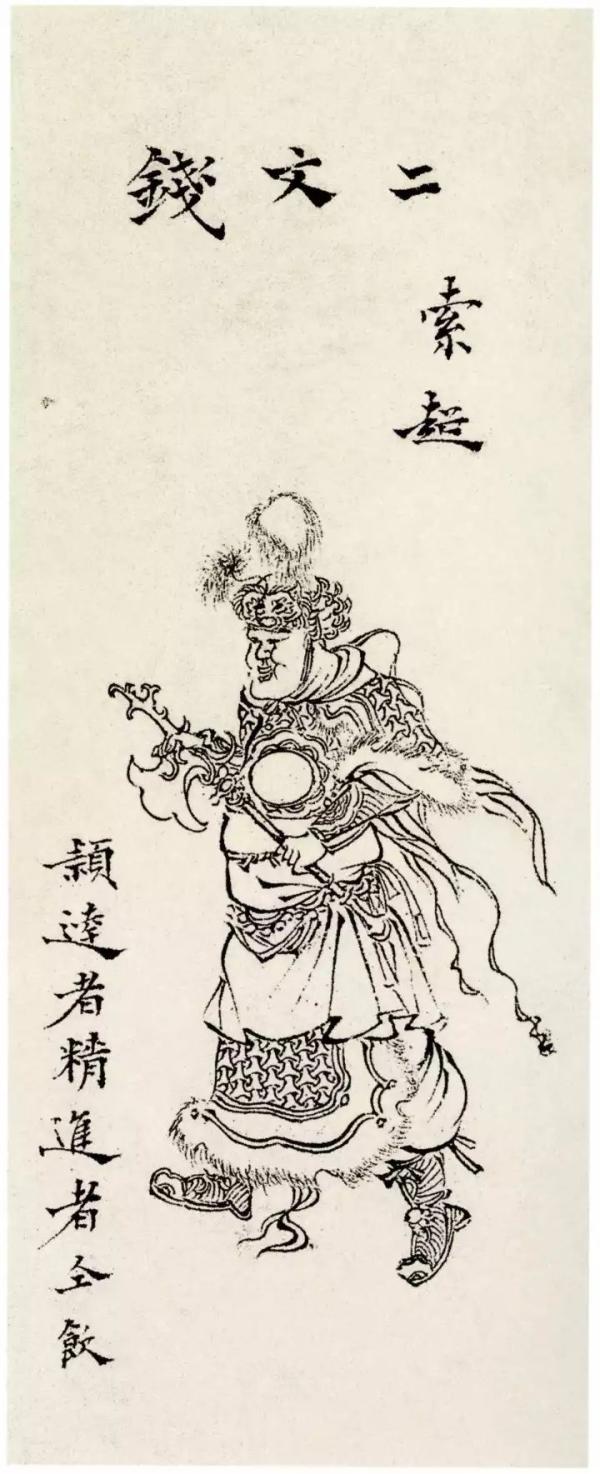
One of "Water Margin Leaves" (replica)
At the end of the Ming Dynasty, Chen Laolian's "Water Margin Leaves" spread all over the world, so that it was difficult for later painters to draw heroes of the Water Margin out of his category.
"The Story of the West Chamber" is one of the most illustrated books by Chen Hongshou. There are three types of books circulating: "The West Chamber" by Zhang Shenzhi, "The West Chamber" by Li Jichen, and "Commentary on the West Chamber" by Li Zhuowu. Among Zhang Ben's six illustrations, the first one is the portrait of Yingying, and the rest directly depict the original content, including "Mucheng", "Relieving the siege", "Peeking at the Jane", "Frightening Dream" and "Reporting the Victory". Literary accomplishment and high artistic level.
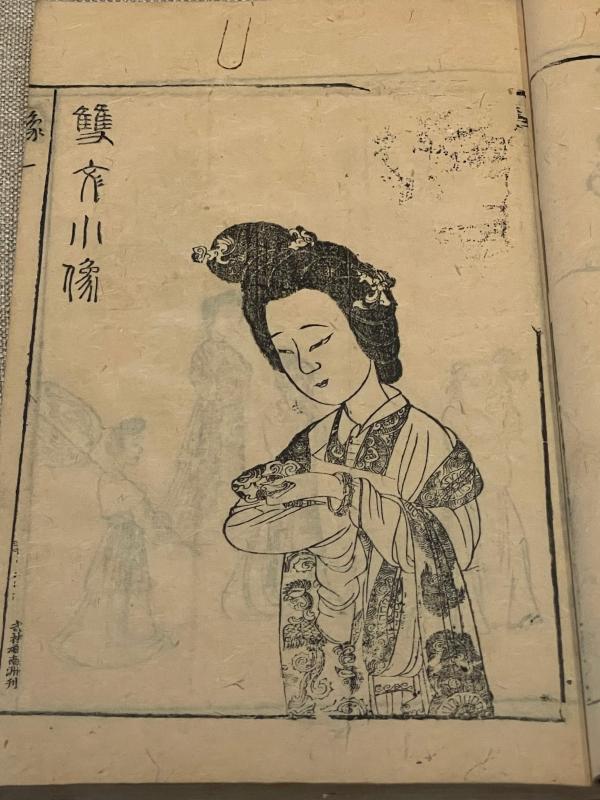
Chen Hongshou's painting "The Secret Edition of Mr. Zhang Shenzhi's True North West Chamber" Chongzhen block copy in the Ming Dynasty
As the most outstanding figure painter in China in the seventeenth century, Chen Hongshou's artistic charm is enduring, and his followers are like crucian carp. The concubines Hu Jingran, son Chen Xiaolian, daughter Chen Daoyun, students Yan Zhan, Lu Xin, Sima Wei, Shen Wuji, Wei Xiang, etc. The following Wang Shugu, Luo Pin, Hua Yan, and Huang Shen were able to melt the old lotus painting method and create a new look. In modern times, there are "Three Renowns on the Sea", Zhang Daqian, Xie Zhiliu, Cheng Shifa and so on. Not only that, Chen Hongshou's works have also been widely spread overseas, profoundly affecting Japanese Ukiyo-e, and indirectly affecting the Impressionist painters of Monet and Van Gogh, and the impressionist paintings have affected the world, so Chen Hongshou also occupies an important position in the world art circle. status.

Statue of Huang Shen Zhongkui in Shaoxing Museum

Zheng Banqiao Ammonite Chart Scroll
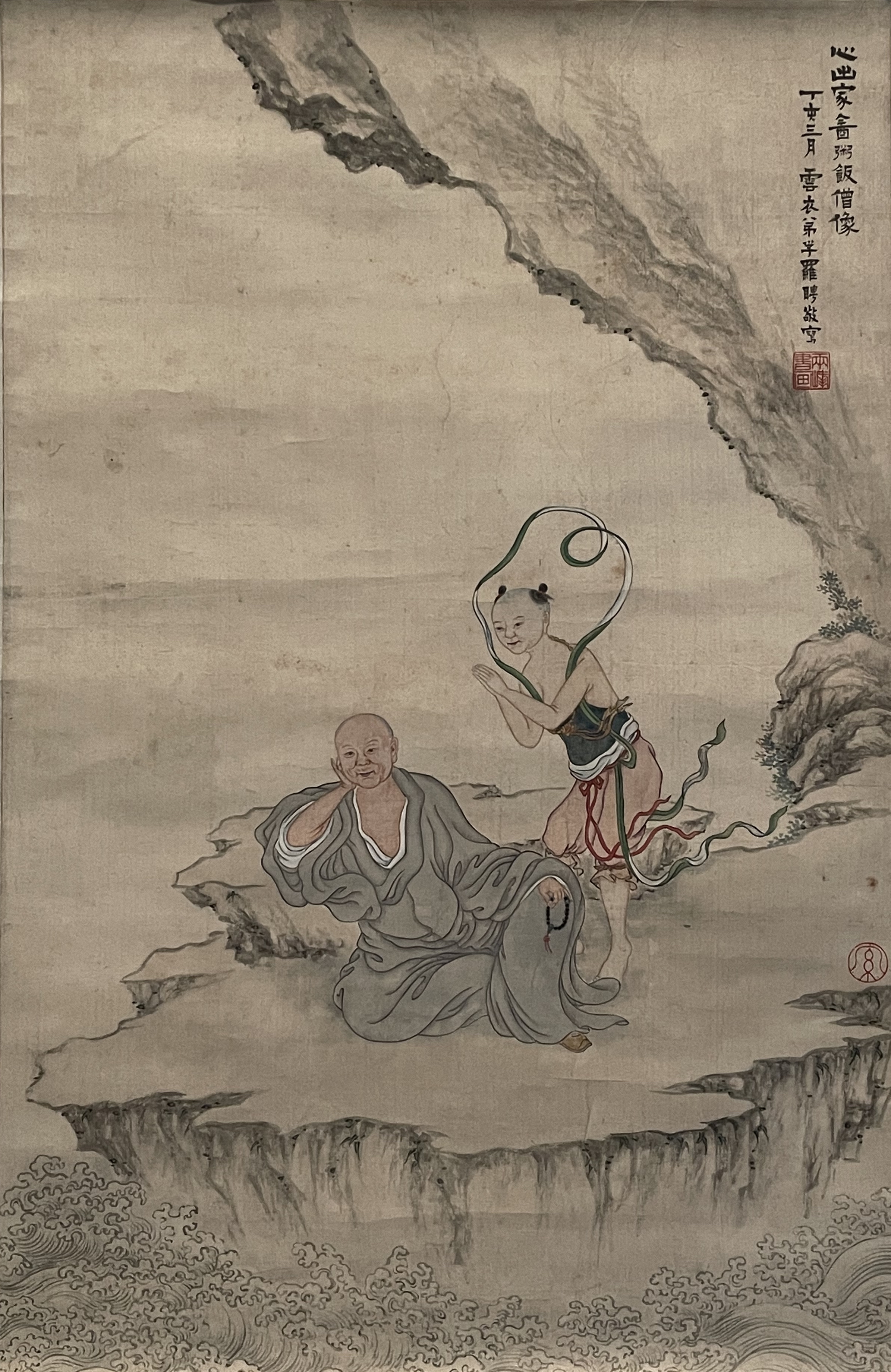
Luo Pin's "The Scroll of Jinnong" Shaoxing Museum
Although Chen Hongshou's calligraphy skills are not as good as those of painting, his brushwork is fresh and elegant, and he is very elegant. His outstanding line performance in painting is due to the deep calligraphic roots. In his early years, he studied Ouyang Tong's "Monument of Master Daoyin" and thought it was a bone base. Middle-aged and practising Huai Su Kuang Cao, and teachers Chu Suiliang, Mi Fu, Yan Zhenqing, integrated and integrated, forming a simple and thin, rigid and soft, sparse and steep, astringent pen and free, unrestrained and beautiful, able to mature and then born, introverted and yet Sophisticated art style.
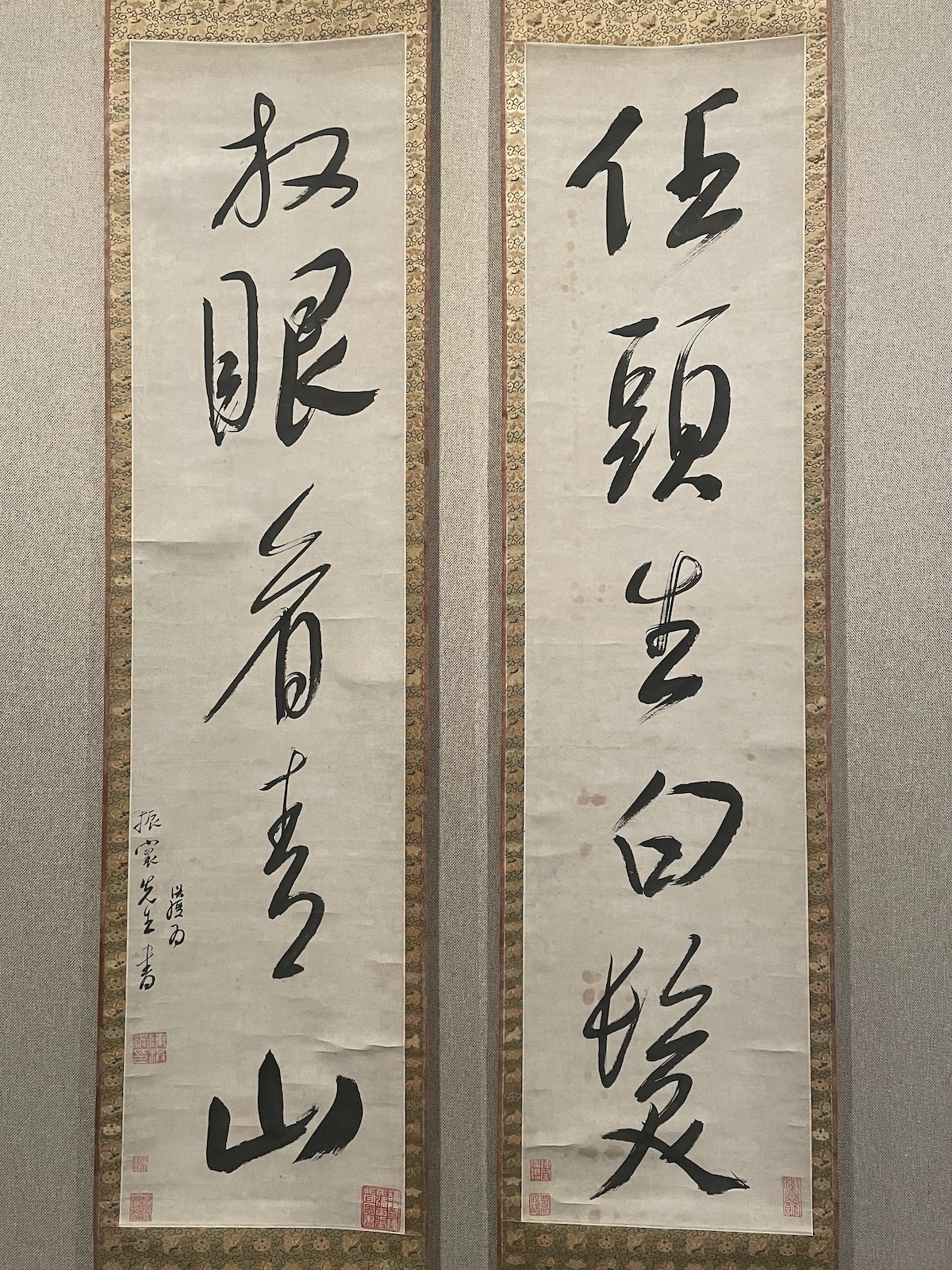
Wuxi Museum Collection

Chen Hongshou calligraphy
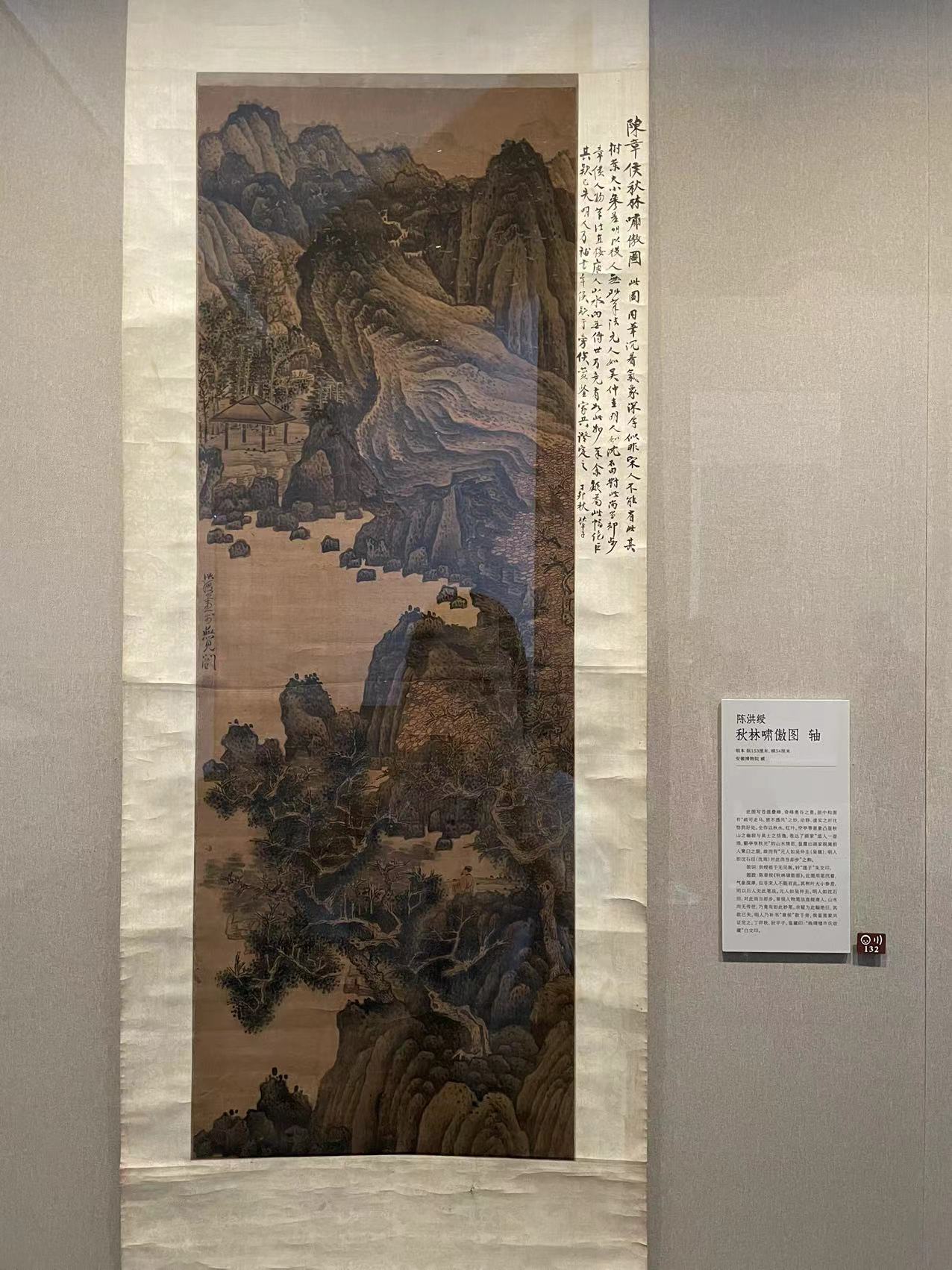
Chen Hongshou, Autumn Lin Xiaoao, Scroll, Collection of Anhui Provincial Museum
Shaoxing Museum is based on the sorting of local cultural relics. At the same time, it also exhibits Chen Hongshou's book "Shuimu Yongnian" (collected by Zhuji Museum) collected from the folks.

Chen Hongshou's book plaque "Shuimu Yongnian" is his rare masterpiece

"Gao Gu Qi Hao - Exhibition of Chen Hongshou's Painting and Calligraphy"

"Gao Gu Qi Hao - Exhibition of Chen Hongshou's Painting and Calligraphy"
It is reported that the exhibition will last until December 20, during which a batch of exhibits will be replaced.

